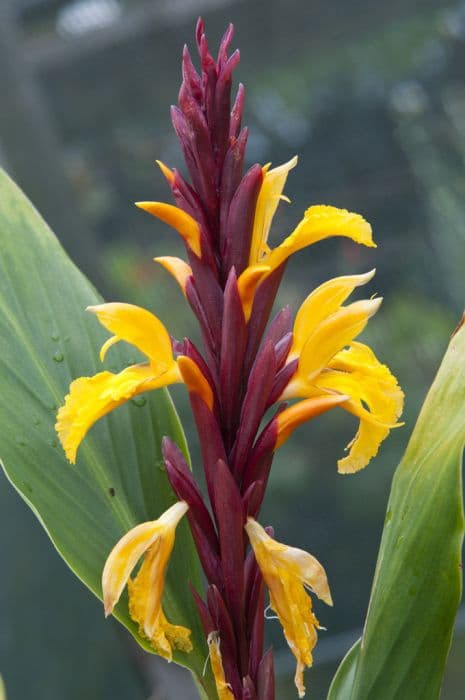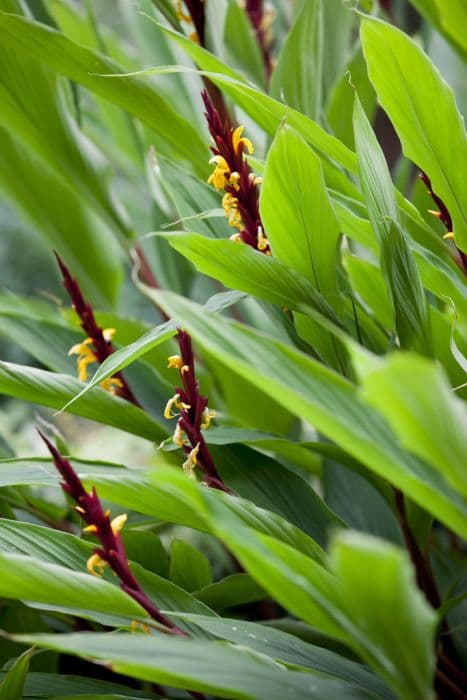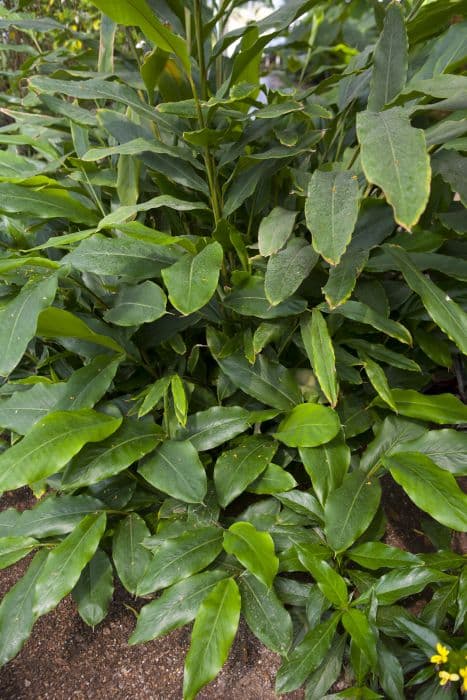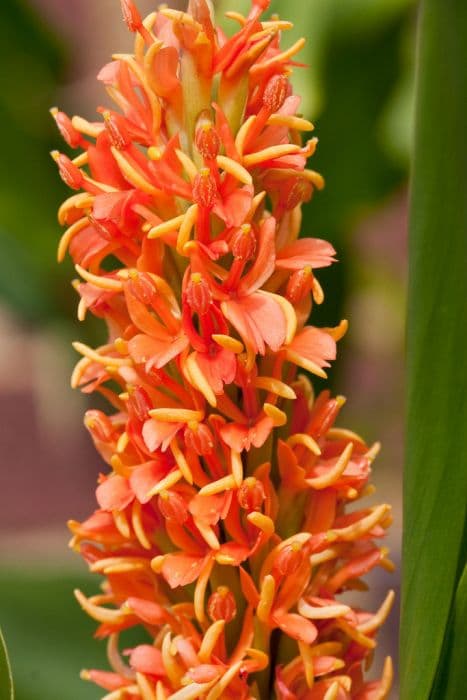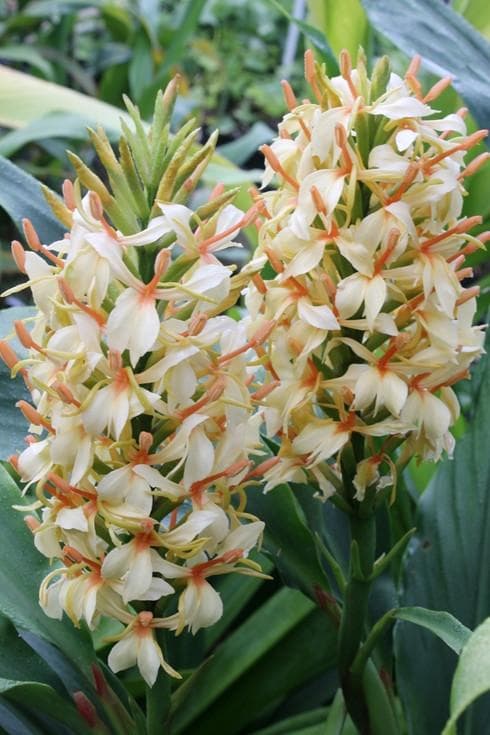Hume's Roscoea Roscoea humeana

ABOUT
Roscoea humeana is a perennial herb that is part of the ginger family. This plant is characterized by its lance-shaped leaves that create a lush greenery appearance. The leaves, which emerge from the base, grow in a linear or slightly curved manner, presenting a textural contrast with their smooth to slightly ribbed surface. The flowers of Roscoea humeana are particularly striking. They are typically a shade of purplish-pink, but can also come in colors ranging from lavender to a deeper purple. These attractive blossoms are usually funnel-shaped, spreading out to reveal delicate, petal-like lobes that may have a lighter coloration or white streaks, offering a beautiful pattern contrast. One of the distinctive features of these flowers is the labellum, a central petal that stands out from the rest due to its shape and often a varied coloration. The center of the flower may additionally have a yellow or white patch, which can draw the attention of pollinators. Furthermore, the stalks that hold the flowers are sturdy and can carry several blooms each, forming a column of color that adds visual interest. The flowers are borne in a succession at the top of the stem, creating a tiered effect that enhances the ornamental value of the plant. The overall aspect of Roscoea humeana is one of lush, green foliage paired with a striking floral display. It is a plant that brings a sense of exotic flair to a garden, with a bloom season that adds color and beauty.
About this plant
 Names
NamesSynonyms
Hume's Roscoea
Common names
Roscoea humeana var. atropurpurea, Roscoea purpurea var. humeana.
 Toxicity
ToxicityTo humans
Roscoea humeana, commonly known as Roscoea, does not have a pronounced reputation for being toxic to humans. There is limited information suggesting that it may have toxic properties, and as such, the symptoms of poisoning are not well-documented. It is generally advisable with any plant to exercise caution and avoid ingestion unless it is known to be safe and edible.
To pets
Similar to the information available for humans, Roscoea humeana, known simply as Roscoea, is not commonly listed as a toxic plant for pets. There are no well-documented cases or specific symptoms associated with Roscoea poisoning in pets, indicating that it may not pose a significant risk. Nonetheless, it is always prudent to prevent pets from ingesting plants that are not confirmed to be safe for consumption.
 Characteristics
CharacteristicsLife cycle
Perennials
Foliage type
Deciduous
Color of leaves
Green
Flower color
Purple
Height
1-2 feet (30-60 cm)
Spread
0.5-1 feet (15-30 cm)
Plant type
Herb
Hardiness zones
6
Native area
China
Benefits
 General Benefits
General Benefits- Ornamental Value: Roscoea humeana is valued for its exotic and showy flowers, making it a popular choice for ornamental gardens.
- Biodiversity Support: The plant can provide food and habitat for various insects, supporting local biodiversity.
- Soil Erosion Control: The roots of Roscoea humeana can help stabilize soil and prevent erosion in garden settings.
- Low Maintenance: Being a hardy perennial, it requires minimal care once established, making it suitable for low-maintenance landscaping.
- Shade Tolerance: This plant can thrive in partially shaded conditions where other plants might struggle, allowing for versatile garden design.
 Medical Properties
Medical Properties- This plant is not used for medical purposes.
 Air-purifying Qualities
Air-purifying QualitiesThis plant is not specifically known for air purifying qualities.
 Other Uses
Other Uses- Roscoea humeana, commonly known as the orchid-like ginger, can be used as a natural dye source for textiles, providing a range of soft hues depending on the mordant used.
- The fibrous roots of this plant have been traditionally used in some cultures for making small brushes and brooms.
- In landscape architecture, the orchid-like ginger can be used to create 'green sculptures' due to its distinctive foliage and flowers.
- The plant's leaves can be used in crafting, such as pressing for botanical prints or inclusion in eco-friendly homemade paper for special artistic effects.
- Its vibrant flowers can serve as organic confetti at celebrations, being both decorative and biodegradable.
- Roscoea humeana is sometimes used as a food wrap in cooking; its leaves can wrap small portions of food, infusing a subtle flavor during steaming.
- The plant can also be used as a living mulch, which helps retain soil moisture and suppress weed growth without the need for synthetic mulches.
- Gardeners may use the seed pods of orchid-like ginger in dry flower arrangements or as a natural seed source for crafting jewelry.
- Its strong, vertical growth habit allows the orchid-like ginger to be used as a natural marker or border plant in garden designs.
- The dense clumps formed by the plant can provide natural habitat niches for small garden fauna, supporting biodiversity.
Interesting Facts
 Feng Shui
Feng ShuiThe Roscoea is not used in Feng Shui practice.
 Zodiac Sign Compitability
Zodiac Sign CompitabilityThe Roscoea is not used in astrology practice.
 Plant Symbolism
Plant Symbolism- Unique Beauty: The distinct appearance and beautiful flowers of Roscoea humeana symbolize unique beauty and the appreciation of the same in others.
- Rarity: As a plant not commonly found in every garden, it can represent the rarity and preciousness of certain qualities or people in one's life.
- Adaptability: This plant's ability to thrive in various conditions can symbolize resilience and adaptability to life's changing circumstances.
- Mystery: The exotic origins and lesser-known status of Roscoea humeana may embody mystery or the allure of the unknown.
- Healing: In some traditions, plants are used for medicinal purposes and healing, representing physical or emotional healing properties.
 Water
WaterFor Roscoea humeana, commonly known as Hardy ginger, water when the top inch of soil feels dry, typically once every week during the active growing season. During the dormancy period in winter, reduce watering frequency to every other week or less, depending on the humidity and temperature of the environment. It's essential to avoid waterlogging, so ensure good drainage. When watering, use about 16 ounces of water for small pots and up to a gallon for larger pots, ensuring even soil moisture without drenching the plant.
 Light
LightHardy ginger prefers partial shade with bright, indirect light. The ideal location offers morning sunlight and afternoon shade or dappled sunlight throughout the day, mimicking its natural woodland habitat. Avoid placing it in direct, harsh sunlight as it may scorch the leaves.
 Temperature
TemperatureHardy ginger thrives best in temperatures between 60°F and 75°F. It can tolerate a minimum temperature of 50°F but should not be exposed to frost or temperatures below 32°F. The plant prefers a stable temperature range without drastic fluctuations.
 Pruning
PruningPruning Hardy ginger isn't typically necessary except to remove dead or damaged foliage. The best time for pruning is in the spring before new growth starts. Deadheading spent flowers can encourage more blooms, but extensive pruning should be avoided to preserve the plant's natural form.
 Cleaning
CleaningAs needed
 Soil
SoilThe best soil mix for Roscoea humeana, also known as Himalayan ginger, should be rich, well-draining, and high in organic matter. A mixture of loam, perlite, and compost works well, and it should be slightly acidic to neutral with a pH between 6.0 and 7.5.
 Repotting
RepottingHimalayan ginger should be repotted every 2 to 3 years to refresh the soil and accommodate growth. It’s best to repot in spring before new growth starts.
 Humidity & Misting
Humidity & MistingHimalayan ginger thrives in high humidity conditions, aiming for a humidity level of 60-70% for optimal growth.
 Suitable locations
Suitable locationsIndoor
Provide bright, indirect light and maintain high humidity indoors.
Outdoor
Place in partial shade, protect from strong winds and frost.
Hardiness zone
6-9 USDA
 Life cycle
Life cycleRoscoea humeana, commonly known as Hume's Roscoea, begins its life cycle as a seed, germinating in moist, well-drained soil in spring. After germination, it develops a rosette of lance-shaped leaves and a fleshy, underground rhizome. The plant matures and blooms in late spring to summer with purple, tubular flowers that emerge sequentially from the bracts at the stem tips. Following pollination, typically by bees, the flowers produce capsules containing numerous small, black seeds. As a perennial herb, Hume's Roscoea dies back to its rhizome in autumn, where it remains dormant through the winter. With the arrival of warmer weather in the next spring, the plant resumes growth from the rhizome, completing its annual cycle.
 Propogation
PropogationPropogation time
Spring to summer
Roscoea humeana, commonly known as hardy ginger, is best propagated by division, ideally just after the plant has finished flowering in late summer to early autumn. To do so, carefully dig up the clump of the plant, minimizing harm to the root system. Using a sharp knife or spade, divide the rhizomes into sections, ensuring each section has at least one growth bud. Plant the divisions at the same depth they were originally growing, in well-draining soil. Space them about 12 inches (approximately 30 centimeters) apart, and water them thoroughly after planting to encourage root development. This method stimulates rapid growth as the divisions are already mature plants, and they will usually settle in and start growing with vigour in the following growing season.
